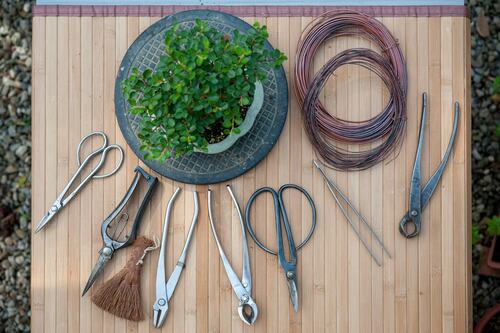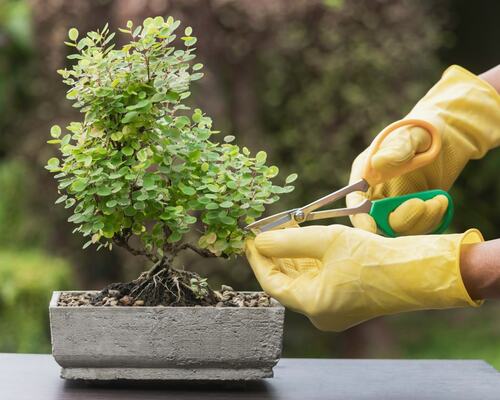Bonsai Tree Kit
Introduction
Growing a bonsai takes years of patience and care. Growing these miniature trees can be a very rewarding experience for those with the dedication. However, it can be tricky finding everything you need to get started as a beginner. Bonsai tree kits are a great way to get started in the world of bonsai. This convenience gives those just starting out all the materials they need so they can dive right into the basics of bonsai gardening.
Materials Needed
A bonsai tree kit usually has everything needed to get started in this rewarding hobby. This includes young bonsai saplings or seeds, important tools, and instructions on how to care for your bonsai.
For Your Tree

Starter Bonsai Trees in a Store – Photo by Erik Mclean
Bonsai kits will first come with all the basics needed to plant your bonsai:
- Sapling or Seed: The heart of any bonsai kit is the plant itself. Some common species of bonsai trees included are juniper , maple , pine , or ficus . Whether starting with a seed or a young tree, these plants are selected to thrive under the specific care and training involved in bonsai cultivation.
- Pot: The pots used in bonsai are more than just containers; they are integral to the aesthetic and health of the tree. These pots come in various shapes, sizes, and styles and are often glazed or unglazed ceramic. They’re also always designed with drain holes to prevent water from pooling around the roots. A drainage mesh is often included to cover these holes, keeping the soil in place.
- Soil Mix: Unlike regular potting soil, bonsai soil is specially made to have the right amount of drainage and air circulation and keep nutrients in the soil. Usually, bonsai soil has a blend of akadama , pumice, and lava rock . This mix makes sure that the roots receive the right amount of oxygen while preventing waterlogging. This is crucial for the health of bonsai trees.
For Maintenance

An Example of a Bonsai Tree Kit
Bonsai kits will also come with all the basic tools needed to maintain your bonsai:
- Pruning and Shaping Tools: To keep the miniature size and shape of the bonsai you want, precise tools are necessary. High-quality pruning shears and scissors are used for trimming branches and leaves, while wire cutters help in shaping the tree. Bonsai wire, which is available in various gauges, is used to guide the growth of branches. This allows for intricate styling over time.
- Watering Tools: Proper watering is necessary for bonsai health. A watering can with a fine nozzle can water your bonsai gently. A misting bottle can also do the same thing. This ensures that the soil remains moist without disturbing the delicate roots.
- Instructional Guide: For beginners, detailed instructions and guides can be helpful. These resources offer step-by-step instructions on planting, pruning, wiring, and ongoing care. They also give insights into the philosophy and aesthetics behind bonsai. This helps novices appreciate the deeper aspects of this art form.
How to Care for Your Bonsai

An Outdoor Bonsai Tree – Image by Antonios Ntoumas from Pixabay
The instructional booklet included in your bonsai kit will help you understand all the details you need to know about growing the species of bonsai included in your kit. Here are the general guidelines you need to know about growing a bonsai tree.
Placement
- Indoor Bonsai: Indoor bonsai usually only do well by a south-facing window. This is because there is a lot of light in this area. Light is crucial for the health of your tree. Many indoor bonsai are also usually tropical species and need high humidity. Humidity trays can help these trees get the humidity they need. They should also be placed somewhere in the house with a consistent temperature throughout the day.
- Outdoor Bonsai: Most trees will need to be placed outside year-round. This is because the annual cycle is crucial for the health of most trees. You should place your bonsai in a bright spot with lots of light. In the summertime, some afternoon shade will be helpful so that your tree doesn’t get scorched by the summer sun.
Watering
Watering is one of the most important parts of caring for your bonsai. There are a few factors that go into watering your bonsai:
- Water when soil gets dry: Don’t water when soil is still wet, but don’t let your tree dry out, either.
- Never water on a routine: Your tree is unique. It’s better to watch your tree for signs that it needs watering rather than watering on a regular schedule.
- Use the right soil mixture: This greatly influences how often trees need to be watered. Most thrive on a mixture of ½ akadama , ¼ pumice, and ¼ lava rock. However, if you can’t water regularly, then it may be better to use a mixture that retains more water instead.
- When watering your bonsai: You should thoroughly soak the entire root system. Keep watering until water runs out of the bottom drainage holes, and repeat if needed a few minutes later.
When watering your tree, you should do so using a watering can with a fine nozzle to prevent the soil from being washed away. If indoors, you can place your tree in your kitchen sink and water the tree thoroughly before placing it back. The best water to use when watering your bonsai is rainwater. This is because it has no added chemicals in it. If this is not possible, using tap water works fine as well.
Fertilizing
There are three basic elements in any fertilizer: Nitrogen, phosphorous, and potassium.
- Nitrogen: Increases growth of leaves and stems or the growth above ground
- Phosphorus: Contributes to healthy root growth and growth of fruits and flowers
- Potassium: Enhances overall plant health
Growers often use different ratios of NPK for different trees and at different times of the year. However, experts are increasingly recommending using the same NPK ratio throughout the bonsai growth cycle.
Most bonsai trees should be fertilized during the entire growing season (early spring–mid-fall). Older trees are often fertilized less often depending on the species, time of year, stage of development, and the health of tree. Indoor trees can be fertilized all year round since they don’t experience seasonal changes. In this case, a balanced liquid fertilizer may be best. Something important to remember, however, is to never overfeed your tree.
Pruning

Careful Pruning of a Bonsai Tree
Pruning and shaping these trees is crucial to maintaining their health, beauty, and structure. Although Japanese maples naturally have a graceful form, proper pruning can enhance this and make sure your tree grows healthy and strong.
There are 4 different pruning techniques you’ll need to prune your tree:
- Structural Pruning: Pick the main trunk and branches that will define your bonsai’s shape. Then, remove any unwanted large branches that do not fit the design. This forms the main shape and structure of the bonsai. This is usually done once and then followed by minor adjustments if needed.
- Maintenance Pruning: Regularly pinch back new growth to encourage denser foliage and a more compact form. Remove any shoots that grow in unwanted directions or that crowd the structure as well. This maintains the shape and refines the structure of the bonsai and is done throughout the growing season.
- Leaf Pruning: Carefully prune larger leaves during the growing season. This is done by cutting the leaf stem and then leaving the base to fall off naturally. Removing some of the leaves from the tree can also balance growth. This makes the leaf size smaller, increasing the number of branches and making it easier for light to reach the lower layers of the tree. This should be done once or twice per growing season depending on the tree’s vigor and health.
- Root Pruning: Remove about one-third of the root mass, focusing on large, thick roots to encourage fine root growth. This should only be done during repotting, which occurs every 2-3 years for young trees, and every 3-5 years for older trees.
Wiring
Wiring can be tricky. Whenever possible, wire two branches of similar thickness near each other using a single piece of wire. This technique is called double-wiring, which provides more support for both branches. You should wire all branches you intend to shape before bending them.
When wiring the entire bonsai tree, work from the trunk to the primary branches, then start on the secondary branches. Be sure to use wires that are one-third the thickness of the branch you are wiring. This is so that the wire is thick enough to hold the branch in its new position, but not too thick for the branch.
Repotting

Older Bonsais Require Less Frequent Repotting – Photo by Chengxin Zhao
How often you should repot depends on the size of the pot and the tree species of your bonsai. Fast-growing bonsai trees need to be repotted every two years, sometimes sooner. Older, more mature trees need to be repotted every three to five years. Repotting is not something that should be routine. Check your bonsai early in spring by carefully removing the tree from its pot. If roots are circling the root system, it needs to be repotted. If roots are still contained within the soil, leave it and check again next spring.
The best time to repot your bonsai is early in the spring. This is because the tree is still dormant, but the buds are beginning to swell. The tree isn’t sustaining full-grown foliage at this point, so it won’t be as damaged from repotting and can be repaired quickly. This is especially true for the root system.
In Conclusion
Overall, bonsai tree kits are an easy way for beginners to get started with this rewarding hobby.
They make the setup much easier by providing all the necessary materials in one package. This convenience makes sure that novices have everything they need to start their bonsai journey without the need to find all the individual materials. These kits also often come with species of bonsai that are well suited for beginners , meaning they are more resilient and easier to care for.
In conclusion, bonsai tree kits are a perfect gateway into the world of bonsai, giving all the essentials needed to embark on this timeless and fulfilling hobby. Whether you are drawn to the meditative aspects of bonsai or the challenge of shaping living art, these kits offer a structured and accessible path to start growing your own miniature forest.


